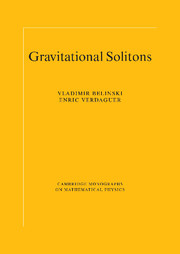Book contents
- Frontmatter
- Contents
- Preface
- 1 Inverse scattering technique in gravity
- 2 General properties of gravitational solitons
- 3 Einstein–Maxwell fields
- 4 Cosmology: diagonal metrics from Kasner
- 5 Cosmology: nondiagonal metrics and perturbed FLRW
- 6 Cylindrical symmetry
- 7 Plane waves and colliding plane waves
- 8 Axial symmetry
- Bibliography
- Index
1 - Inverse scattering technique in gravity
Published online by Cambridge University Press: 17 August 2009
- Frontmatter
- Contents
- Preface
- 1 Inverse scattering technique in gravity
- 2 General properties of gravitational solitons
- 3 Einstein–Maxwell fields
- 4 Cosmology: diagonal metrics from Kasner
- 5 Cosmology: nondiagonal metrics and perturbed FLRW
- 6 Cylindrical symmetry
- 7 Plane waves and colliding plane waves
- 8 Axial symmetry
- Bibliography
- Index
Summary
The purpose of this chapter is to describe the Inverse Scattering Method (ISM) for the gravitational field. We begin in section 1.1 with a brief overview of the ISM in nonlinear physics. In a nutshell the procedure involves two main steps. The first step consists of finding for a given nonlinear equation a set of linear differential equations (spectral equations) whose integrability conditions are just the nonlinear equation to be solved. The second step consists of finding the class of solutions known as soliton solutions. It turns out that given a particular solution of the nonlinear equation new soliton solutions can be generated by purely algebraic operations, after an integration of the linear differential equations for the particular solution. We consider in particular some of the best known equations that admit the ISM such as the Korteweg–de Vries and the sine-Gordon equations. In section 1.2 we write Einstein equations in vacuum for spacetimes that admit an orthogonally transitive two-parameter group of isometries in a convenient way. In section 1.3 we introduce a linear system of equations for which the Einstein equations are the integrability conditions and formulate the ISM in this case. In section 1.4 we explicitly construct the so-called n-soliton solution from a certain background or seed solution by a procedure which involves one integration and a purely algebraic algorithm which involves the so-called pole trajectories.
- Type
- Chapter
- Information
- Gravitational Solitons , pp. 1 - 36Publisher: Cambridge University PressPrint publication year: 2001



